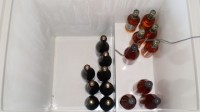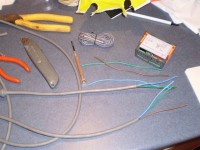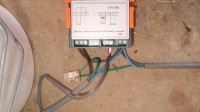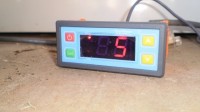 I finally got the chance to set up my chest freezer as a fridge a couple of weeks ago, and I’ve been testing it out so I could write up this post.
I finally got the chance to set up my chest freezer as a fridge a couple of weeks ago, and I’ve been testing it out so I could write up this post.
You may recall I mentioned that we had an old fridge/freezer running in our garage as a second fridge. With three young kids in the house, we go through a lot of milk, juice, yoghurt and wine. Having a second fridge lets us buy larger quantities of these things once a week, instead of needing to go to the shops every day or two.
I measured the energy use of the old clunker with my [MS5116 mains power meter](http://green-change.com/2008/11/27/ms6115-mains-power-meter-review/), and was surprised to learn that it was using 2.5 kWh of electricity per day. Our total household energy consumption at the time was around 20 kWh per day, so this thing was responsible for 1/8th of that!
A lot of hard-core sustainability geeks around the internet (especially those living off-grid) have toyed with the idea of converting a chest freezer into a fridge. The theory is that it will use a lot less electricity because the horizontal lid doesn’t let the cold air fall out when it’s opened, and it has very thick insulation compared to a fridge. People are claiming some amazing power consumption figures, but would it really work that well?
I bought a 210L chest freezer for $90 second-hand, and [ordered a FridgeMate MkII](http://green-change.com/2009/04/23/progress-on-the-chest-fridge/) digital temperature controller online for $50.
A little bit of wiring is required to set up the digital temperature controller. It’s basically a temperature sensor that can switch a 240v power supply on or off. The simplest way to install it is to take a short electrical extension cord and cut it in half. You can then strip back the wires and connect them into the back of the FridgeMate according to the supplied wiring diagram. This gives you an extension cord with a temperature controller in the middle. One end of the power cord plugs into your powerpoint, and the freezer plugs into the other end.
The photo below shows how mine is wired up – it should help if you’re having trouble following the schematic wiring diagram. In the photo, the right-hand cord is the end with the male plug (i.e. that plugs into the power point) and the left-hand cord has the female plug (i.e. where the fridge plugs in). The cord in the middle with the red and white wires is the temperature sensor, which needs to sit somewhere inside your freezer but not touching the walls. For safety, the controller should be mounted in a project box so nothing can come in contact with the live wires on the back of it.
The FridgeMate can either cut the power when the temperature rises above the set point (if you’re using it to control a heating mat or belt), or it can cut the power when the temperature drops below the set point (if you’re using it to control a fridge or cooling coil). It has a lot of configurable parameters, and comes with an instruction book on how to modify them all, but the instructions list out the recommended settings for use with a fridge. This makes it very easy to program.
Once it’s all set up, the freezer can be plugged in and the power turned on. It didn’t take long for my little freezer to drop to my set point of 3 degrees C, at which point the FridgeMate cut the power. I then opened the lid for a while, and as the temperature rose the FridgeMate cut back in and cooled it down again. Perfect!
So, how much electricity does my chest fridge use?
Once it was loaded up and stabilised, I left the MS6115 on the chest fridge for 24 hours. When I came back, it was reading a cumulative usage of just 0.2 kWh! Given the limited 1-decimal-place reading, I’m calling that 0.2-0.3 kWh. Not bad at all – it’s around 1/10th of the old fridge (at 2.5 kWh/day).
And how is it in use?
 I thought it was fine, but the true test of the usability of the chest fridge was what Megan thought. After a week or so of use, she’s quite happy with it. We’re keeping all the bottles of milk, juice and wine on the bottom of the fridge. Smaller bottles (beer, ginger beer, etc) go on the step, and items like yoghurt, butter, etc go in the basket. Megan actually finds it easier to lift and rearrange the bottles from above than to slide everything in and out on a normal fridge shelf. You have very easy access to everything in the fridge without having to move stuff around.
I thought it was fine, but the true test of the usability of the chest fridge was what Megan thought. After a week or so of use, she’s quite happy with it. We’re keeping all the bottles of milk, juice and wine on the bottom of the fridge. Smaller bottles (beer, ginger beer, etc) go on the step, and items like yoghurt, butter, etc go in the basket. Megan actually finds it easier to lift and rearrange the bottles from above than to slide everything in and out on a normal fridge shelf. You have very easy access to everything in the fridge without having to move stuff around.
Someone asked me what the ambient temperature was when I did these power tests. I didn’t actually measure it at the time, but it would have been around 20 degrees C during the day in the spot where the fridge sits. It probably dropped to about 10-12 degrees C overnight, I’d guess.



To quote from the text:
“With three young kids in the house, we go through a lot of … wine.”
So I got to ask, is it the kids who go through the wine, or the parents because of the kids? 😉
@Jason: It was intentional – the parents go through the wine because of the kids :-). A decent amount of home-brewed ginger beer seems to be consumed, too.
All Things Eco Blog Carnival Volume Fifty Three | Focus Organic.com
[…] Collins presents My Chest Fridge Conversion (“Converting a chest freezer into a super-efficient fridge that uses 1/10th the electricity of the […]
Hi Darren-
I want to try this set up stateside in a camper… I have found a vendor for the Fridgemate MkII in a 110v model, but the description says nothing about whether or not it can handle the kickback of an inductive load. Are you implementing a relay or capacitor to handle inductive load, or does the MkII have a built in capacitor?
I am referencing Tom Chalko’s PDF document from mtbest.net on this subject. Within said document Tom states that the Jaycar WT2300 thermostat he tried first failed after six weeks of use when the relay started suddenly producing large and bright plasma arcs in his kitchen!!
I am REALLY trying to avoid anything that could be a fire hazard, and so the relay contacts must be able to handle inductive load.
It seems a nobrainer… if yours is still working, then it must be able to handle it??
@James: To be honest, I’m not sure about how well it handles an inductive load. But it is a “fridgemate”, designed to switch fridges, so I would have to think it can handle them OK. The Jaycar thermostat may be of a more general-purpose design and that’s why it couldn’t handle the job? Dunno. I did see one chest fridge conversion that added a circuit to dampen the startup spike, for use with batteries and an inverter – possibly it was the Mt Best one, but I can’t recall. My FridgeMate is still working fine!
Thank you for posting this, nice to finally see that at least one other human being, after Tom Chalko, has taken up the challenge to produce what the entire global refrigeration industry has failed to provide. I intend to be the third, unless I can find a commercially made version.
I am outraged that this is not made available to regular consumers. Have I just not been looking hard enough, or is the concept of chest fridges really that rare?
@Yosh Hash: I know of a few people who’ve done this, I guess most of them don’t have blogs or feel the need to tell everyone about it like I do :-). The big problem with chest fridges going mainstream is the amount of testing etc involved in bringing a new appliance to the Australian market. There’s a lot of testing for electrical safety, standards compliance, Energy Star rating, etc that the manufacturer has to pay for before they can even sell one unit. And let’s face it, these things are never going to sell as many units as an LG side-by-side with water and ice dispenser.
It’s a pity, but then I don’t think they could make them as cheap as my one anyway! It really wasn’t hard to set up, and it’s been working great so far.
Let me know how you go!
Hi Mate
Have just been reading your website. Just wanted to thankyou. Throughly enjoyed the read. Some great info.
Cheers
Patrick
@Patrick: Thanks mate, hope it was of some use (or at least entertainment!) to you.
http://www.haieramerica.com/en/category/Home_Appliances/Freezers/Access_Plus_Dual_Zone_Freezers
Well, well, it seems there is at least one actual manufacturer. Haier apparently sells a lot of products to major retailers like Walmart and Home Depot, so it shouldn’t take much to have them stock it- people just need to ask for it and buy it. Here in Canada, they don’t seem to have them, but I’m going to keep making inquiries until they do.
@yoshhash: Thanks for the link, that’s really interesting. If anybody sees one of these in a store, please let us know!
Hi Darren
Thanks for posting this! I am interested in converting a chest freezer to a “can cooler” for cooling my milk– I milk goats and don’t have enough of them to merit a bulk tank. I know of people who have done this and love how it works. Basically it will be a freezer filled with water that is kept just over freezing level.
I think the process would be the same as yours except that I am going to have water in mine and will need to seal the joints with caulking. My question for you is did you cut the original thermometer out of the freezer? What was this process like?
Thanks for any thoughts.
@Trillium Hill: There are two general approaches people use. One is to replace the existing thermostat with one that works at a higher temperature range (i.e. replace the freezer thermostat with a fridge thermostat). The other is to do what I did, and use a digital temperature controller with its own thermostat to simply turn the mains power on and off.
For your project, I’d try to find a waterproof tub or box that fits inside your chest freezer rather than sealing the freezer itself with caulking. The caulking may eventually leak. If you use the digital temperature controller method, you could put its temperature probe in your water bath and then set it to maintain a temperature just above freezing. That should work nicely.
I like your web site by the way (assuming it’s trilliumhillfarm.com, and not trilliumhill.com!). Vermont looks beautiful, and I’d like to get over there someday. My neighbour’s daughter and her family live on a farm somewhere in Vermont too.
I’m very interested in this idea as im currently moving out of home and looking at purchasing a fridge. Since a fridge is a hefty investment, I’d like to think this solution would be the best.
My main concern is, what do most people use for a freezer then? Do they go without or do they run a second unit for freezing?
Also, I’ve been looking at Haier chest freezers, but would you suggest anything in particular to purchase?
@David: We have our two chest freezers side by side – one running as a fridge, and one as a freezer. It’s a lot more economical than the upright equivalent! Sorry, I don’t have the knowledge to recommend any particular brands or models. I’m a fan of buying second-hand, so I’m always limited in choice to what is currently available and I just research those online to come to a decision.
@Darren: I had the same idea, the bonus would be the huge amount of extra storage space for food, but the downside is that having two would take up much more room.
chest fridge conversion « frugalist massive
[…] Mt best chest fridge guide Click on the PDF for all the details Green change chest fridge conversion […]
Hi Darren
Is your freezer conversion still working? As I plan to something similar…
Cheers
Dermot
@Dermot: It was still going strong until earlier this year – I took the thermostat off it and returned it to a freezer as I needed the freezer space when I killed my pigs. Once we get through more of the meat, I’ll convert it back. It’s nice having a temporary hack like this, as it gives you flexibility.
Hi Darren.
I am looking to convert my 200lt homemaker chest freezer into a fridge, I want to be able to brew lager at around 12 deg C, and cold condition the beer at around 3 deg C, could you tell me if the fridgemate would allow the chest fridge to reach that 12-15 deg C range, I have looked at changing just the thermostat over, but I like the idea of the fridgemate digital temp control better with the visual display.
Regards John.
@John: Yep, I think the FridgeMate is what you need! According to the specs, it can control temperatures from -40C up to +70C, with +/- 1C accuracy. Perfect for the two different modes you want to use it in.
Ten Tips to Cut Cost of Running Your Refrigerator | Cooking Manager
[…] Note: For safety, freshly cooked foods should be stored while hot even though this will make your refrigerator work harder. Older refrigerators use more energy and do not keep food as fresh. New refrigerators have flimsy parts and a shorter lifespan. It may not pay to invest in a old refrigerator, especially one manufactured before 1993. If you are looking to take 90% off the cost of refrigeration, buy a simple chest freezer and adjust the thermostat. […]
I used a Walmart Black and Decker 5 CU FT chest freezer(the most eff.I could find) cost $163 + tax and 4 Walmart wire baskets (total $24) that fit perfectly. Don’t attach the racks with screws though this will risk puncturing the cooling tubes. Assemble them together as a rack with a few feet of thin aluminum angle (Home Depot) and leave them standing inside for easy removal to clean The controller came from Ebay (China) for $25 and is meant for inductive loads. On my middle shelf beer stock it holds a constant 2.3 C (about 37F) and consumes an average (including cooling new warm supplies) of 232 watts per day or one quarter of a normal fridge. Ambient average T. about 72F. Ran a little warmer I can achieve 125 watts per day but I like my beer really cold!
@Sir Sparks: You did well! Good tips with the racks. It doesn’t hurt to keep the temperature low in these fridges, since they’re so efficient and you don’t open them very often. It keeps things like milk and juice fresher for longer. I’m quite partial to an ice-cold beer myself!
Here is another tip but at present only useful for Off Grid Solar people (like me). However soon Smart Metering will be coming to all of us and at that point it would be worth doing for all;
Why should I waste my batteries on a freezer? With 8 hours a day (roughly) solar time and 16 hours too dark for solar any freezer will use power from the battery bank 2/3 of the time and only 1/3 direct from the solar panels. This causes additional power losses in battery charging and also means a shorter battery bank lifetime. I changed my freezer (another Walmart Black and Decker) so that the times are reversed ie. 1/3 power from battery bank and 2/3 direct from solar panels.
Simply purchase a $16 Lowes (20 segment) ELECTRONIC plug in timer. I set mine for a total of 5 3/4 hours in time in the eight hour “day” and then 11 minutes every hour for the other 16 hours. Result is is; 1/3 battery power 2/3 solar direct power. Fluctuation is from -20C (about -5F) to -12C (about +10F. Which is fine for long freeze storage as the food spoiling micro organisms only start to grow again (slowly) above 9.6C ( +15F) so the food is safe. Although some people have remarked that frequent temperature fluctuation can rupture cell walls and spoil taste this is ONLY true when between 0C and 4C when undergoing frequent freeze/defrost at which point the water expands a massive 10% volume (AKA floating Icebergs)and can rupture food cell walls.
Just remember set times to keep max temp below +15F plus some safety margin.
PS. Set thermostat to max or better yet install a bypass switch to disable it. This is the same function as a “Fast Freeze” switch.
I could not refrain from commenting. Perfectly written!
My husband is a home brewer who kegs.
Reading your post, i know it was while ago, but I had to add that alot of home brewers do similar conversions of chest freezers in to keg fridges. Good height for kegs and taps, good insulation, cuts down on costs of running a second fridge just for the beer.
We use Fridge mates on fridges to maintain perfect brew temp all year round. They can also then do double duty as over flow food storage during party season (xmas and we have a lot of summer birthdays in the family) by dialling it up to the correct fridge temp.
There have been a few draw backs come to light in the home brew world of chest freezer conversions – especially with using the freezers existing thermostat and a fridge mate. The freezer compressor is designed to run at freezing level not the on/off for short bursts that occurs to maintain only fridge temps and the compressor has a much higher incidence of just giving up the ghost after a few years.
We considered a chest freezer conversion but decided to go with an additional, but newer (more energy starts) second hand fridge for the beer and keep our chest freezer for frozen meat.
Just something to consider when weighing up the pros/cons and costs of such a conversion. Please read up on http://www.aussiehomebrewer.com/forum/index.php forum for more info.
Cheers.
@Wendylady: Thanks for adding to the discussion! Yep, I bought the FridgeMate from a home brew supplier. I read a bit in the forums about all the pros and cons, and decided to go with a cheap second-hand freezer rather than a fridge. A chest fridge (using an old freezer) uses way less energy than any second-hand (or even reasonably-priced new) fridge would.
One drawback is, like you say, it can reduce the working life of the freezer, for a number of reasons. The energy savings and versatility seem to make up for that, though.
In actual fact, for the same temperature differential (offset) a fridge or freezer will cycle LESS often when set to a higher temperature so should last longer.
If people experience problems it is most likely due to setting too tight a temperarure differential ie. +1C off +1.5C ON. I have mine set to +1 OFF and +3.5C ON and the chest freezer only comes on about once per hour for a few minutes. The cheap mechanical freezer stat normally installed in a new freezer has these same large differential characteristics which is why it lasts longer.
@Sir Sparks: That makes sense. The controller I use has an adjustable hysteresis band – I think I had it set to about 2C or so, which worked well.
Hovabator Incubator Fridgemate Hack
[…] to use a Fridgemate digital temperature controller (the same device I’ve previously used to turn a chest freezer into a super-efficient refrigerator) to accurately control the temperature of my Hovabator […]